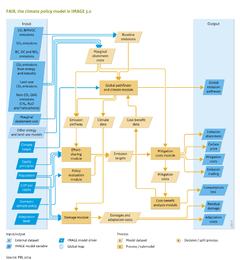Climate policy: Difference between revisions
Jump to navigation
Jump to search
No edit summary |
Oostenrijr (talk | contribs) No edit summary |
||
| (4 intermediate revisions by 2 users not shown) | |||
| Line 3: | Line 3: | ||
|Model-Database=MAGICC model; AD RICE model; TIMER model; POLES model; Enerdata Global Energy & CO2 Data; IIASA database; | |Model-Database=MAGICC model; AD RICE model; TIMER model; POLES model; Enerdata Global Energy & CO2 Data; IIASA database; | ||
|KeyReference=Den Elzen et al., 2011a; Den Elzen et al., 2008; Hof et al., 2009; Van Vliet et al., 2009; | |KeyReference=Den Elzen et al., 2011a; Den Elzen et al., 2008; Hof et al., 2009; Van Vliet et al., 2009; | ||
|Reference=UNFCCC (2015); UNFCCC (2015b); UNEP (2016); | |Reference=UNFCCC (2015); UNFCCC (2015b); UNEP (2016); Rogelj et al., 2016; Den Elzen et al., 2015a; Kuramochi et al., 2016; Hof et al., 2016; | ||
|InputVar=Population; GDP per capita; CO2 emission from energy and industry; CO and NMVOC emissions; Non-CO2 GHG emissions (CH4, N2O and Halocarbons); Marginal abatement cost; Climate target; Domestic climate policy; Marginal abatement costs; BC, OC and NOx emissions; SO2 emissions; Land-use CO2 emissions - grid; Equity principles; Adaptation level; | |InputVar=Population; GDP per capita; CO2 emission from energy and industry; CO and NMVOC emissions; Non-CO2 GHG emissions (CH4, N2O and Halocarbons); Marginal abatement cost; Climate target; Domestic climate policy; Marginal abatement costs; BC, OC and NOx emissions; SO2 emissions; Land-use CO2 emissions - grid; Equity principles; Adaptation level; | ||
|Parameter=Other energy and land-use models; | |Parameter=Other energy and land-use models; | ||
|OutputVar=Carbon price; Emission abatement; Global emission pathways; Mitigation costs; Emission trading; Consumption loss; Adaptation costs; Residual damage; | |OutputVar=Carbon price; Emission abatement; Global emission pathways; Mitigation costs; Emission trading; Consumption loss; Adaptation costs; Residual damage; | ||
|Description=<div class= | |Description=<div class="version changev31"> | ||
With the 2015 Paris Agreement, all Parties to the United Nations Framework Convention on Climate Change (UNFCCC) have agreed to limit global warming to 2 °C compared to pre-industrial levels and to pursue efforts to further limit this increase | With the 2015 Paris Agreement, all Parties to the United Nations Framework Convention on Climate Change (UNFCCC) have agreed to limit global warming to 2 °C compared to pre-industrial levels and to pursue efforts to further limit this increase to a maximum of 1.5 °C [[UNFCCC (2015b)]]. | ||
</div> | </div> | ||
Revision as of 14:44, 14 July 2017
| Component is implemented in: |
|
| Related IMAGE components |
| Models/Databases |
| Key publications |
| References |
Key policy issues
- What global greenhouse gas emissions pathways would meet the well below 2 °C climate target?
- What is the effect of effort-sharing approaches on regional and national emission reduction targets and on the cost of climate policies?
- What is the effect of the NDCs on achieving the long term 2 ºC target?
- What are the trade-offs between mitigation costs, adaptation costs, and climate change damage?
